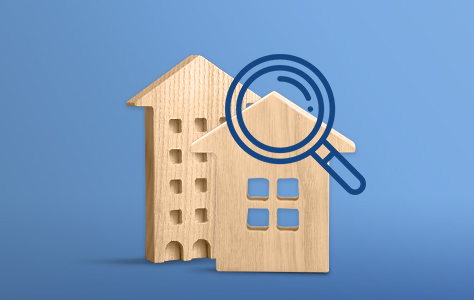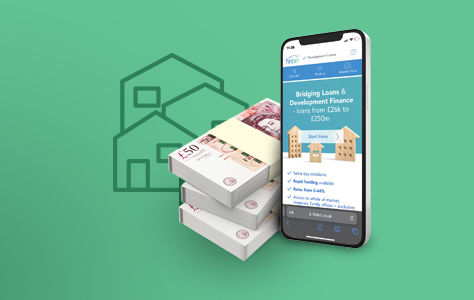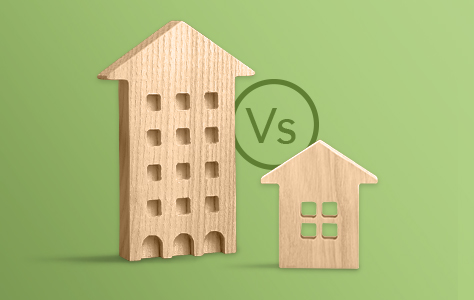
Property Refurbishment Finance specialists
Property refurbishment finance is a short-term secured loan that funds the refurbishment of buildings.
Property developers use this finance to fund light or heavy residential, commercial or semi-commercial property refurbishments.
What can light property refurbishment finance be used for?
Light property refurbishment finance can help fund the purchase of the property and any minor updates and repairs, typically not requiring major structural changes or planning consent. Examples of light refurbishment include:
- Painting and decorating
- Updating fixtures and fittings
- Replacing carpets or flooring
- Repairing doors and windows
- Refreshing bathrooms and kitchens without full renovation
- Improving lighting and electrical fittings
- Landscaping and external cosmetic improvements
- Minor plumbing repairs
- Replacing or repairing the roof without structural changes
- Enhancing energy efficiency with new insulation or heating systems.
What can heavy property refurbishment finance be used for?
Heavy property refurbishment finance typically funds the initial property purchase and extensive modifications and structural changes, including obtaining planning consent and complying with building regulations. Examples of heavy refurbishment projects include:
- Full-scale renovation of kitchens and bathrooms
- Major structural alterations, such as removing or adding walls
- Complete rewiring of electrical systems
- Replacing plumbing and central heating systems
- Roof replacement or significant repairs
- Foundation repairs or modifications
- Extensive external work, including new windows, doors, and façade restoration
- Conversion of property use, such as from commercial to residential dwellings
- House-to-Flat conversion
- House-to-HMO conversion
- Loft conversions or basement excavations to add living space.
Our Property Refurbishment Finance service
We arrange property refurbishment finance for all residential, semi-commercial and commercial properties. Our lenders are ready to provide loans to property investors and developers looking to refurbish almost any property, including residential dwellings, buy-to-lets (BTLs), HMO conversions, flip opportunities, golf clubs, hotels, guest houses, restaurants, pubs and offices. We can accept almost any property or group of properties as security to raise the funds you need, provided it's located in England, Scotland, Wales, or Northern Ireland.
- Market-leading property bridging loans from £26,000 to £250m
- Monthly interest rates from 0.44% pm
(Lower rates for £700,000+ loans or less than 50% LTV) - LTVs up to 65% (up to 100% finance if additional collateral is available)
- Automated valuation options and dual legal representation
- No monthly payments with interest rolled-up options
- Terms up to 24 months
We provide a fast, reliable service to help you get the finance you need at the best available rates.
We consider all types of credit history, including non-status, bad or adverse and don't perform automated credit checks, so there's no footprint from enquiring.
With incredible relationships with the UK's top lenders, including specialist lenders, family offices and private investors, we can source the bridging loan you require:
up to £300k loans in 3 days
up to £750k loans in 7 days
up to £250m from 14 days
Where your timeline is critical and short, we're confident we can arrange your bridging loan. Get your best, no-obligation quote today.
Refurbishment Finance uses
We arrange all types of property refurbishment:
- Light refurbishment & heavy development loans
- Loans for residential BTL refurbs
- Loans for residential purchase, refurb and flip opportunities
- Loans for auction properties
- Commercial refurbishment finance
- Student accommodation refurbishment finance
- Loans for Pub, Office, Hotel refurbishments and conversions
- Development finance for:
Ground-up development finance, Development exit finance and Mezzanine finance
Property Refurbishment Finance Lending Criteria
| Loan to value (LTV) | 65% maximum (100% with additional security) 100% Build financing And Joint Venture (JV) Finance available |
| Loan term | 3 to 24 months |
| Loan amount | £26,000 up to £250m |
| Interest options | Rolled-up, retained or serviced |
| Interest rates | From 0.44% |
| Decision | Immediate decision in principle |
| Completion | Up to £300k in 3 days Up to £750k in 7 days Up to £250m from 2 weeks |
| Early repayment fees | None |
| Availability | Secured on your property in England, Scotland, Wales and Northern Ireland Individuals, Companies, SPVs No credit & adverse credit considered |
| Exit strategy | Sale or refinance |

A comprehensive guide to Property Refurbishment Finance
Property refurbishment finance is a specialised form of funding that provides financial support for individuals or companies involved in property refurbishment projects.
Whether you're a property developer, investor, or homeowner looking to renovate a property, property refurbishment finance offers a range of solutions to meet your funding needs.
This guide will provide you with valuable insights into property refurbishment finance, including its key features, advantages, disadvantages, eligibility criteria, and alternatives.
Contents
Key features of Bridging Loans for Property Refurbishment
Bridging loans are a common form of property refurbishment finance. They offer several key features, including:
Short-term financing: Bridging loans are typically provided for a short period, usually ranging from a few months to a year. They are designed to bridge the gap between the purchase of a property and its long-term financing or sale.
Quick access to funds: Bridging loans often have a streamlined application process, allowing borrowers to access funds quickly, sometimes within a matter of days.
Flexible repayment options: Borrowers can choose to repay the loan either at the end of the term or through monthly interest payments. This flexibility allows borrowers to align their repayments with their cash flow.
Secured loans: Bridging loans are secured against the property being refurbished or other assets, providing lenders with collateral in case of default.
Lending criteria for Property Refurbishment
The lending criteria for property refurbishment finance may vary between lenders, but common factors considered include:
Experience and track record: Lenders prefer borrowers with a proven history of successful property refurbishment projects.
Property valuation: Lenders will assess the current and potential value of the property being refurbished.
Exit strategy: Borrowers need to demonstrate a viable exit strategy, such as selling the property or refinancing it after the refurbishment.
Repayment ability: Lenders assess the borrower's ability to repay the loan, which may include evaluating income, credit history, and existing debts.
Advantages of Property Refurbishment Finance
Quick access to funds: Property refurbishment finance provides fast access to capital, allowing borrowers to seize opportunities and start refurbishment projects promptly.
Flexibility: Property refurbishment finance offers flexible repayment options, allowing borrowers to tailor the loan structure to their needs.
Increased property value: Refurbishment can significantly increase the value of a property, providing the potential for higher returns on investment.
Leveraged investment: Property refurbishment finance allows borrowers to leverage their investment capital, enabling them to undertake larger projects or multiple refurbishments simultaneously.
Disadvantages of Property Refurbishment Finance
Higher interest rates: Property refurbishment finance typically carries higher interest rates than traditional mortgages or loans due to the short-term nature and increased risk associated with refurbishment projects.
Additional costs: Refurbishment projects often involve additional costs such as planning permission fees, building regulations compliance, and professional services, which can impact overall profitability.
Market volatility: Property markets can fluctuate, and changes in property values can affect the profitability of refurbishment projects.
Does the property need to have planning permission?
The requirement for planning permission depends on the nature and extent of the refurbishment works. Some projects may fall under permitted development rights, allowing certain modifications without formal planning permission.
However, significant alterations or changes to property use typically require planning permission. It is essential to consult local planning authorities or seek professional advice to determine if planning permission is necessary for your refurbishment project.
Loan-to-Value (LTV) for light and heavy Property Refurbishment finance
The Loan-to-Value (LTV) ratio represents the percentage of the property value that can be borrowed.
LTV ratios can vary based on the type of refurbishment and the lender's risk appetite. For light property refurbishment, where the refurbishment works are minimal, LTV ratios may range from 65% to 75%.
In heavy property refurbishment, where extensive renovation or conversion is required, LTV ratios might be lower, typically between 50% and 70%.
Loan duration for Property Refurbishment Finance
The loan duration for property refurbishment finance is generally short-term, typically ranging from a few months to a year.
The borrower typically wants to complete the refurbishment as quickly as possible, increase the market value of the property in order to refinance the loan onto a better, lower interest rate which comes with longer term commercial mortgages.
The duration does however, depend on factors such as the scope of the refurbishment works, the time required to complete the project, and the borrower's exit strategy.
Users of Property Refurbishment Finance
Property refurbishment finance is utilised by a variety of individuals and entities, including:
Property developers: Developers who specialise in refurbishing properties for resale or rental purposes.
Business owners: Business owners may use property refurbishment finance to refurbish their business premises or repurpose it for revenue diversification.
Investors: Individuals or companies looking to purchase and renovate properties for capital appreciation or rental income.
Homeowners: Individuals renovating their own homes to enhance living conditions or increase property value.
Scenarios where Property Refurbishment Finance might be used
Purchasing a property at auction: Property refurbishment finance can enable buyers to quickly secure a property at an auction and fund the necessary refurbishment works.
Property conversion: Converting a commercial property into residential units or repurposing a property for a different use often requires refurbishment finance.
Renovating distressed properties: Purchasing properties in poor condition and renovating them to increase their value and market appeal.
Adding value to existing properties: Refurbishing properties to add extensions, upgrade facilities, or improve energy efficiency.
Eligibility for Property Refurbishment Finance
Eligibility criteria for property refurbishment finance may include:
- Demonstrable experience in property refurbishment or relevant industry experience.
- Adequate funds for the refurbishment works, including a deposit and contingency reserve.
- Proof of a viable exit strategy, such as a sales agreement or refinance commitment.
- A strong credit history and evidence of the ability to service the loan.
Timeframe for obtaining Property Refurbishment Finance
The timeframe for obtaining property refurbishment finance varies depending on the lender and the complexity of the project. In some cases, funds can be made available within days, while more complex projects may require additional due diligence and can take several weeks to complete.
Information required for a refurbishment finance application
When applying for property refurbishment finance, expect to provide the following information:
- Personal or company financial statements and bank statements.
- Proof of identity and address.
- Details of the property being refurbished, including its current and potential value.
- Cost estimates for the refurbishment works and any associated professional services.
- A schedule of works and list of contractors, including the contact details of the project manager and main contractor.
- Details of the exit strategy, such as a sales agreement or refinance commitment.
Types of properties that light and heavy refurbishment finance can be used for in the UK
Light refurbishment finance: This type of finance is suitable for properties that require minimal renovation, such as cosmetic upgrades, minor repairs, or basic improvements to enhance market appeal.
Heavy refurbishment finance: Heavy refurbishment finance is used for properties requiring more extensive renovation or conversion works, such as structural alterations, major repairs, or significant improvements to meet building regulations.
The 5 most profitable ways to use Property Refurbishment Finance
Buy-to-sell strategy: Purchasing properties in need of refurbishment at a discounted price, renovating them, and selling them for a profit.
Buy-to-let strategy: Acquiring properties, renovating them to a high standard, and renting them out for long-term rental income.
Property conversion: Converting commercial properties into residential units or repurposing them for higher-value uses, such as office-to-apartment conversions. Since planning guidance has been relaxed on permitted development this presents developers with new exciting opportunities throughout the UK.
Adding value through extensions: Refurbishing properties can significantly increase a properties value by adding extensions or increasing the usable space to enhance their market value.
Energy efficiency improvements: Renovating properties to improve energy efficiency is a hot topic for the government and will soon likely be a legal requirement, to reduce tenants' running costs, but it also has the benefit of increasing property value for the landlord. According to research however, landlords are raising significant concerns about the renters reform bill.
What's the difference between light and heavy property refurbishment?
Light property refurbishment: This typically involves cosmetic improvements, minor repairs, or basic upgrades to enhance the property's appeal. These projects generally require less time, money, and expertise compared to heavy property refurbishments.
Heavy property refurbishment: This involves more extensive works, such as structural alterations, major repairs, or significant improvements to comply with building regulations. These projects often require higher investment, longer timeframes, and specialised skills.
Is there a difference in the criteria for light property refurbishment finance vs. heavy?
The criteria for light property refurbishment finance and heavy property refurbishment finance may vary among lenders.
Generally, heavy refurbishment projects may have stricter criteria due to the higher level of risk involved. Lenders may require a more experienced track record, larger deposits, lower LTV ratios, and detailed plans for the refurbishment works. Heavy refurbishment finance is usually out of reach for inexperienced developers due to the risk associated with that inexperience.
Alternatives to bridging loans for property refurbishment
Remortgaging: Homeowners may consider remortgaging their property to release equity for refurbishment projects.
Personal loans: For smaller refurbishments, personal loans can provide an alternative source of funding, especially for homeowners.
Development finance: For larger-scale refurbishments, development finance may be more suitable, as it is specifically designed for property development projects.
Joint ventures: Joint venture finance is where you partner with an investor or property developer who provides the necessary funding in exchange for a share of the profits.
Conclusion
Property refurbishment finance offers valuable opportunities for property developers, investors, and homeowners to undertake refurbishment projects.
Whether you're looking to enhance property value, generate rental income, or pursue property development ventures, property refurbishment finance provides the necessary capital to turn your vision into reality.
By understanding the key features, advantages, disadvantages, eligibility criteria, and alternative options, you can make informed decisions and maximise the potential of your refurbishment projects.
We're experienced financial experts who arrange Property Refurbishment Finance and bridging loans for property investors, securing you the best deal from over 200 bridging loan providers including private investors and family offices.
Get expert assistance today, we're on hand to answer any questions about Property Refurbishment Finance.
Call our friendly team on 01202 612934, we're ready to help.
Check out our guides to sourcing property
and property investment blogs

Best 5 property websites for sourcing your next commercial purchase
21st March 2023 14 minute read

Top 6 websites that offer instant online UK property valuations
21st March 2023 7 minute read

Guide to sourcing a property
10th March 2023 4 minute read

Guide to negotiating a property purchase
10th March 2023 4 minute read

Guide to conveyancing
10th March 2023 5 minute read

Guide to Stamp Duty Land Tax
10th March 2023 4 minute read

Guide to property financing options
10th March 2023 5 minute read

Guide to residential vs commercial properties
10th March 2023 4 minute read

Guide to buy-to-let
10th March 2023 4 minute read

Guide to property flipping
10th March 2023 4 minute read

Guide to HMO conversion
10th March 2023 4 minute read

Guide to selling a property
10th March 2023 4 minute read
What is the difference between renovation and refurbishment?
The terms ‘renovation’ and ‘refurbishment’ are often used interchangeably, but there is a difference between the two. Renovation generally refers to making changes or improvements to an existing property structure, while refurbishment usually entails more fit-out interior work.
How does refurbishment finance work?
Refurbishment finance is taken out against a form of security such as a residential property with equity, for 12-24 months, to allow the refurbishment to be completed. The loan is then paid back on either the sale of the property or refinancing. Interest on the loan can be rolled-up (deferred till the end of the loan term), retained (deducted from the loan facility) or serviced (interest is paid monthly).
What is a property refurbishment loan?
A property refurbishment loan can finance upgrades to residential properties such as BTLs, student accommodation and care homes, and commercial properties such as pubs, offices and hotels.
A property refurbishment loan is a type of short-term finance used to fund light refurbishments within a residential or commercial property.
Landlords, investors and property developers will use this type of funding to increase a property's value before letting or selling
